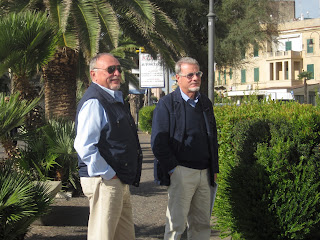The Allied Landing Museum is small but mighty. There are a
number of books, photos and artifacts all related to the invasion and
subsequent battles. Imagine how pleased Dad will be to know that there is a 601
sign proudly hanging on the wall. Most impressive was the collection of photos
on display. We saw many of the locations that we visited yesterday.
 |
| This 601 sign was brought to the museum by another 601 soldier. |
This municipal building is a focal point in Nettuno and was
built long before 1944. Dad may recognize it.
As we drove to Cisterna I read the account of the 601
engagement that occurred here.
Cisterna
was the last stronghold until the road to Rome and was the scene of many
firefights, starting in January of 1944 when Darby’s Rangers were surprised by
the German’s and paid a heavy price. The 601 didn’t get here until late May of
1944. By that time the city was mostly rubble except for a church and a statue
that remained standing. I’m wondering if Dad will recognize these landmarks.
While troops were advancing toward Cisterna from the shore at Anzio, the Polish
Regiment broke through at Monte Cassino resulting in a final push for Rome. The
601 had tragic losses and injuries along the way; they pressed forward. When my
daughter asked Dad once how he could continue in the face of such horror and
sadness he said, “You cry, you pray and you just keep going.”
 |
| This statue in Cisterna is the only surviving original structure. |
 |
| This is the church in Cisterna. It suffered serious damage and was reconstructed. |
On June 4, after 9 months, Rome fell! Several recon soldiers
were sent into the city ahead of all others, just to make sure that the final
parade into the city could occur without any resistance. Dad was one of those
few men. One of his most vivid memories is of arriving in Rome, unopposed, and absorbing
the magnificence of this ancient city.
Imagine, Dad initially landed in Salerno in September and
was finally able to get into Rome in June. By the end of the Italian Campaign
dad and his fellow soldiers were a battle hardened, confident fighting force.
Their job wasn’t finished, however. They left Italy for France then Germany and
Austria for another year of fighting until the war was over.
Although Dad saw the worst of mankind in war, he was still
able to see the best of man in the people, art and culture of Italy. I, too,
while learning about the military aspect of dad’s experience, have been able to
experience the beauty of this marvelous country. I have experienced the
gratitude that the people of Italy have for those who liberated them. I was
presented with a certificate for Dad, from the Mayor of Nettuno, thanking Jim
Stevens for his service and expressing sincere appreciation for his sacrifice. This was another moving moment. I can't wait to present it to Dad.















































